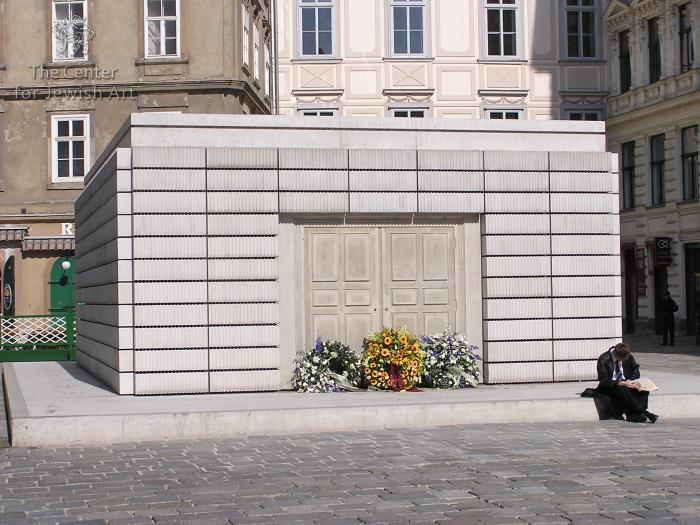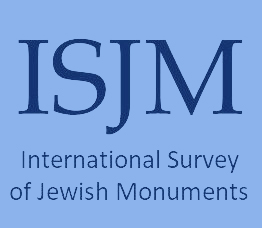Obj. ID: 38468 Judenplatz Holocaust Memorial in Vienna, Austria, 2000

Who is Commemorated?
Austrian victims of the Holocaust
Description
The bunker-like monument takes the form of an inverted library – one where the books’ spines face inward, and their outer edges seem to line all sides of the massive concrete block construction. According to the sculptor, the unread pages represent the unlived lives of Holocaust victims. The names of Nazi camps where so many of them died are inscribed around the base of the block.
According to Simon Wiesenthal, who stood behind the construction: "This monument shouldn't be beautiful. It must hurt." [Connolly, 2000].
Inscriptions
The monument is inscribed in German, English, and Hebrew.
In German:
Zum Gedenken an die mehr als 65 000 österreichischen
Juden, die in der Zeit von 1938 bis 1945 von den
Nationalsozialisten ermordet wurden.
Translation: In commemoration of more than 65,000 Austrian Jews who were killed by the Nazis between 1938 and 1945.
In English:
In commemoration of more than 65,000 Austrian Jews
who were killed by the Nazis between
1938 and 1945.
In Hebrew:
זכר למעלה מ-65.000 יהודים אוסטריים
שנרצחו בשנים 1945-1938
ע"י [=על ידי] הפושעים הנציונלסוציאליסטיים ימ"ש [= ימחו שמם].
Translation: Memory of more than 65,000 Austrian Jews who were murdered in the years 1938-45 by the National Socialist criminals, may their names be obliterated.
On the plinth on the three sides of the memorials, engraved the names of places and camps, where Austrian Jews were killed:
Auschwitz
Bełżec
Bergen-Belsen
Brčko
Buchenwald
Chełmno
Dachau
Flossenbürg
Groß-Rosen
Gurs
Hartheim
Izbica
Jasenovac
Jungfernhof
Kaiserwald
Kielce
Kowno
Łagów
Litzmannstadt
Lublin
Majdane
Maly Trostinec
Mauthausen
Minsk
Mittelbau/Dora
Modliborzyce
Natzweiler
Neuengamme
Nisko
Opatów
Opole
Ravensbrück
Rejowiec
Riga
Šabac
Sachsenhausen
Salaspils
San Sabba
Sobibor
Stutthof
Theresienstadt
Trawniki
Treblinka
Włodawa
Zamość
Commissioned by
The project originated by Simon Wiesenthal and was sponsored by the city of Vienna under Mayor Michael Häupl.
Judenplatz is a singular place of remembrance. There are three main elements to this: the excavated remains of a medieval synagogue, a museum about medieval Viennese Jewry, and, most prominently, a Holocaust memorial designed by British sculptor Rachel Whiteread (b. 1963).
The creation of this memorial, the ‘Nameless Library’, was promoted by the late Simon Wiesenthal as a memorial to Austrian victims of the Holocaust, but also as a complaint against his country and its capital city that no such public recognition of the Holocaust had been created. Work began on the memorial in 1995. After delays, it was completed and dedicated in October 2000.
Like the monument against Fascism at the Albertinaplatz, the construction of the memorial took place in a bitter political climate. Jorg Haider’s right-wing Freedom Party was making gains, reminding Austria and the world that xenophobia and anti-Semitism were hardly things of the past. City authorities also had to deal with the discovery of the remains of a medieval synagogue during excavations for the monument, raising thorny issues: whether construction on this specific site was appropriate, or even against Jewish law. In the end, the excavation of the medieval synagogue and the presentation of the history of its destruction was seen as a necessary and valuable part of the process of commemoration and monument-making.
At the request of the artist, the memorial was not given an anti-graffiti coating. Whiteread explained:
"If someone sprays a swastika on it we can try to scrub it off, but a few daubed swastikas would really make people think about what's happening in their society."
[Connolly, 2000]
Comey, Rebecca. “Memory Block: Rachel Whiteread’s Holocaust Memorial in Vienna,” in Shelley Hornstein and Florence Jacobowitz, eds., Image and Remembrance: Representation and the Holocaust (Bloomington, IN: University of Indiana Press, 2002), 251-271., 251-271.
Connolly, Kate. "Closed books and stilled lives. Review: Whiteread's concrete tribute to victims of nazism." The Guardian, October 26, 2000., https://www.theguardian.com/world/2000/oct/26/kateconnolly (accessed March 6, 2022)
"Judenplatz Holocaust Memorial,"
Wikipedia, https://en.wikipedia.org/wiki/Judenplatz_Holocaust_Memorial.
Uhl, Heidemarie. “From the Periphery to the Center of Memory: Holocaust Memorials in Vienna.” Dapim: Studies on the Holocaust 30, no. 3 (September 2016): 221–242., https://doi.org/10.1080/23256249.2016.1257217 (accessed December 13, 2021)



